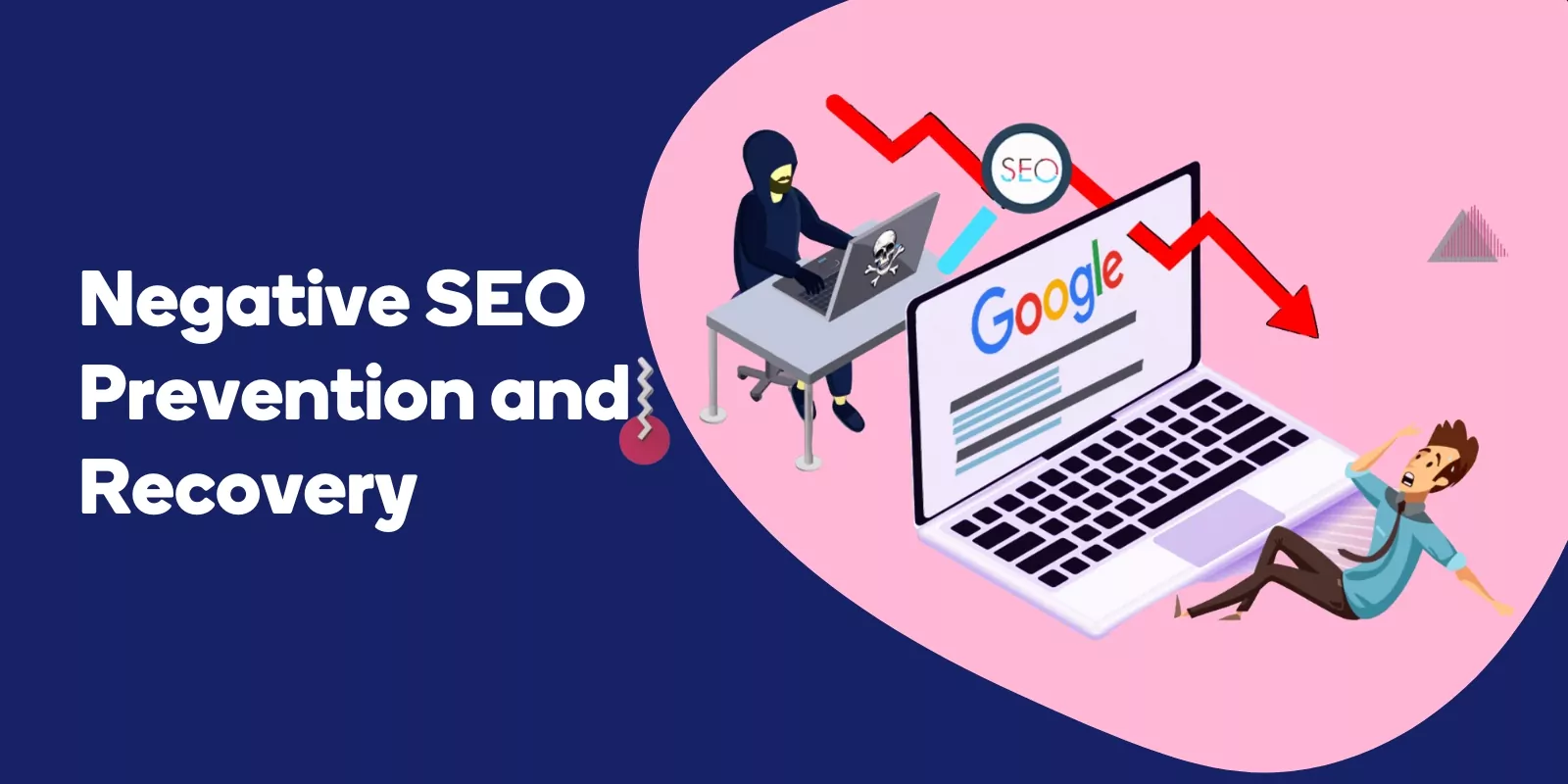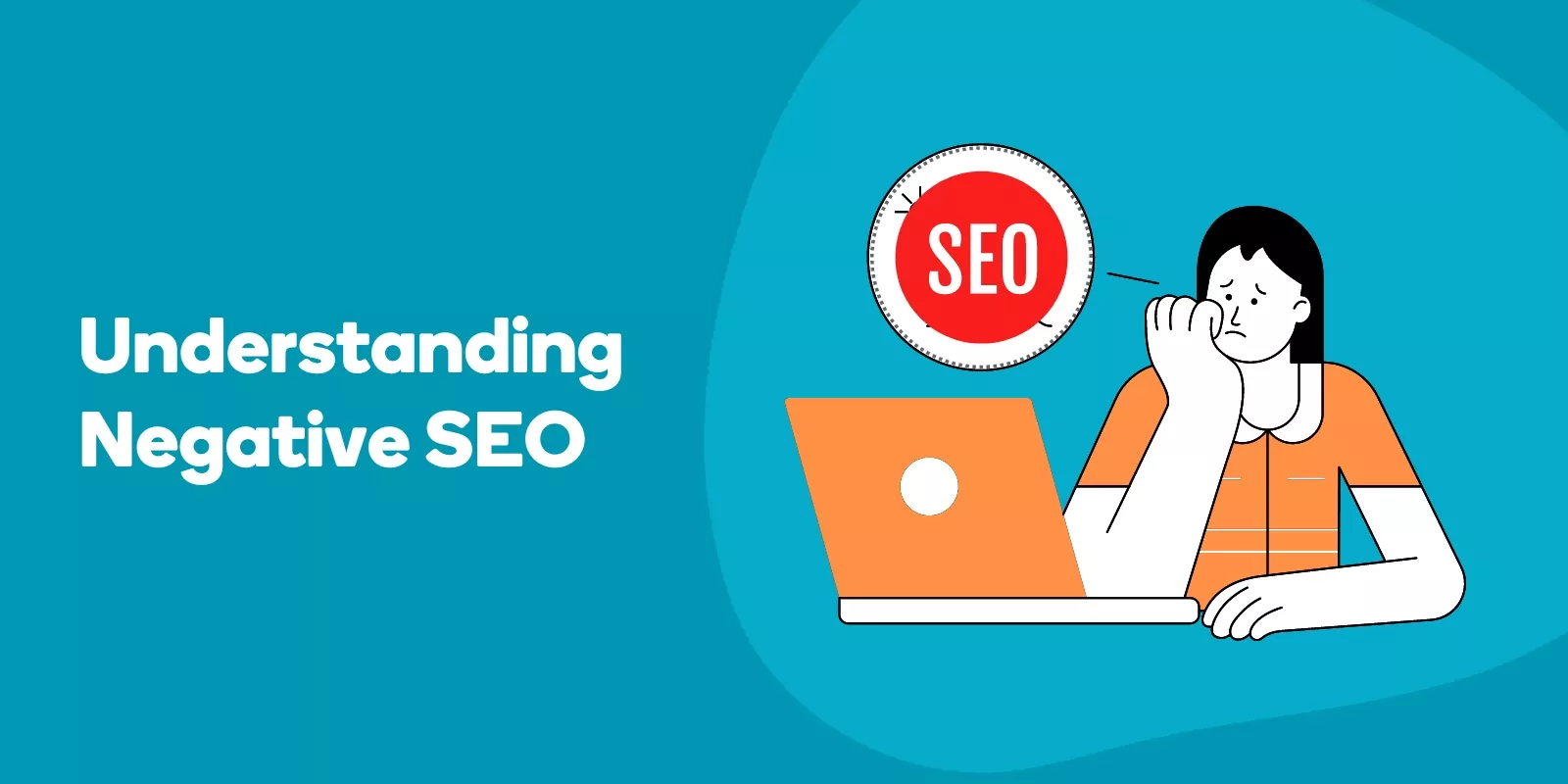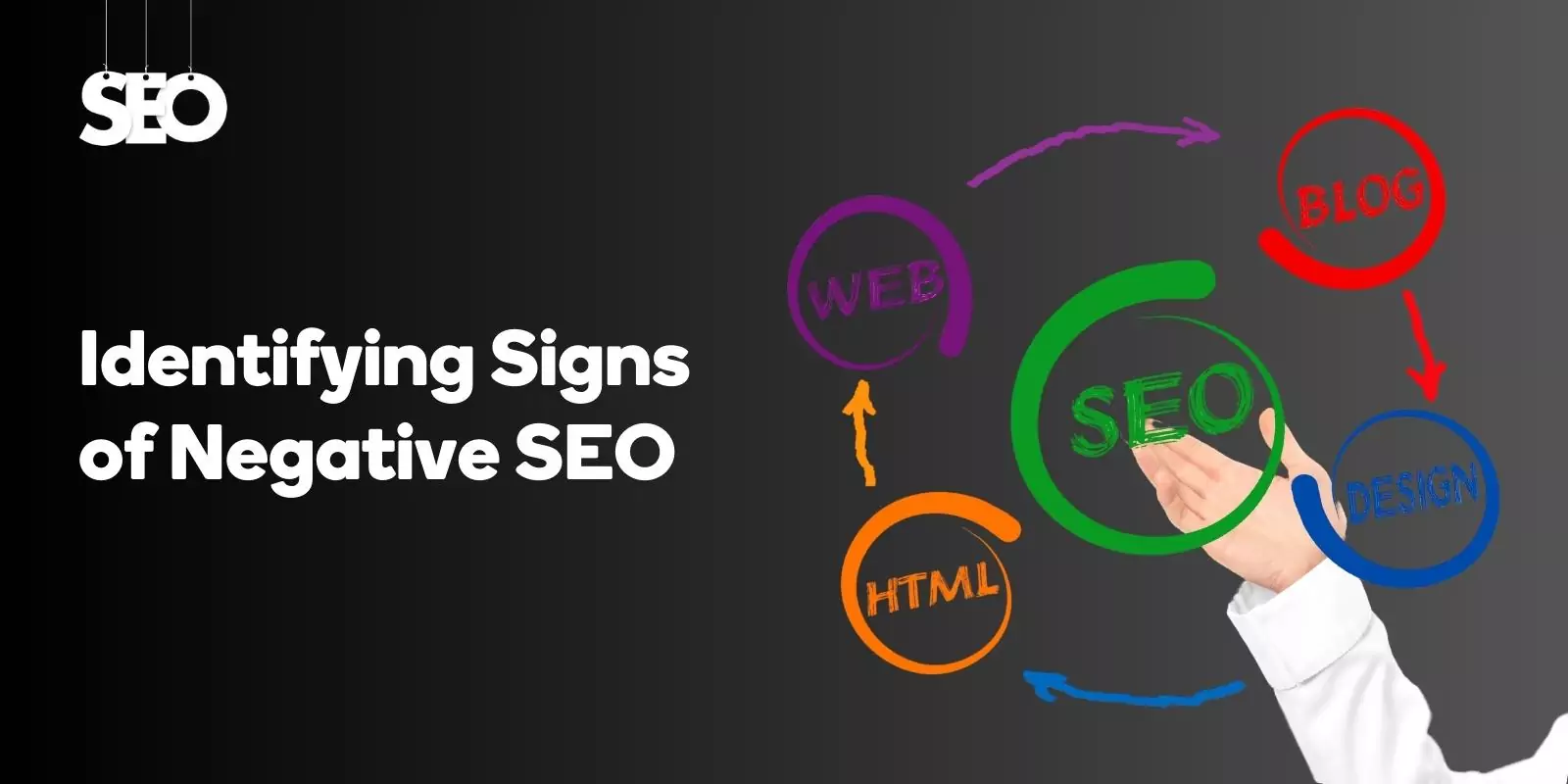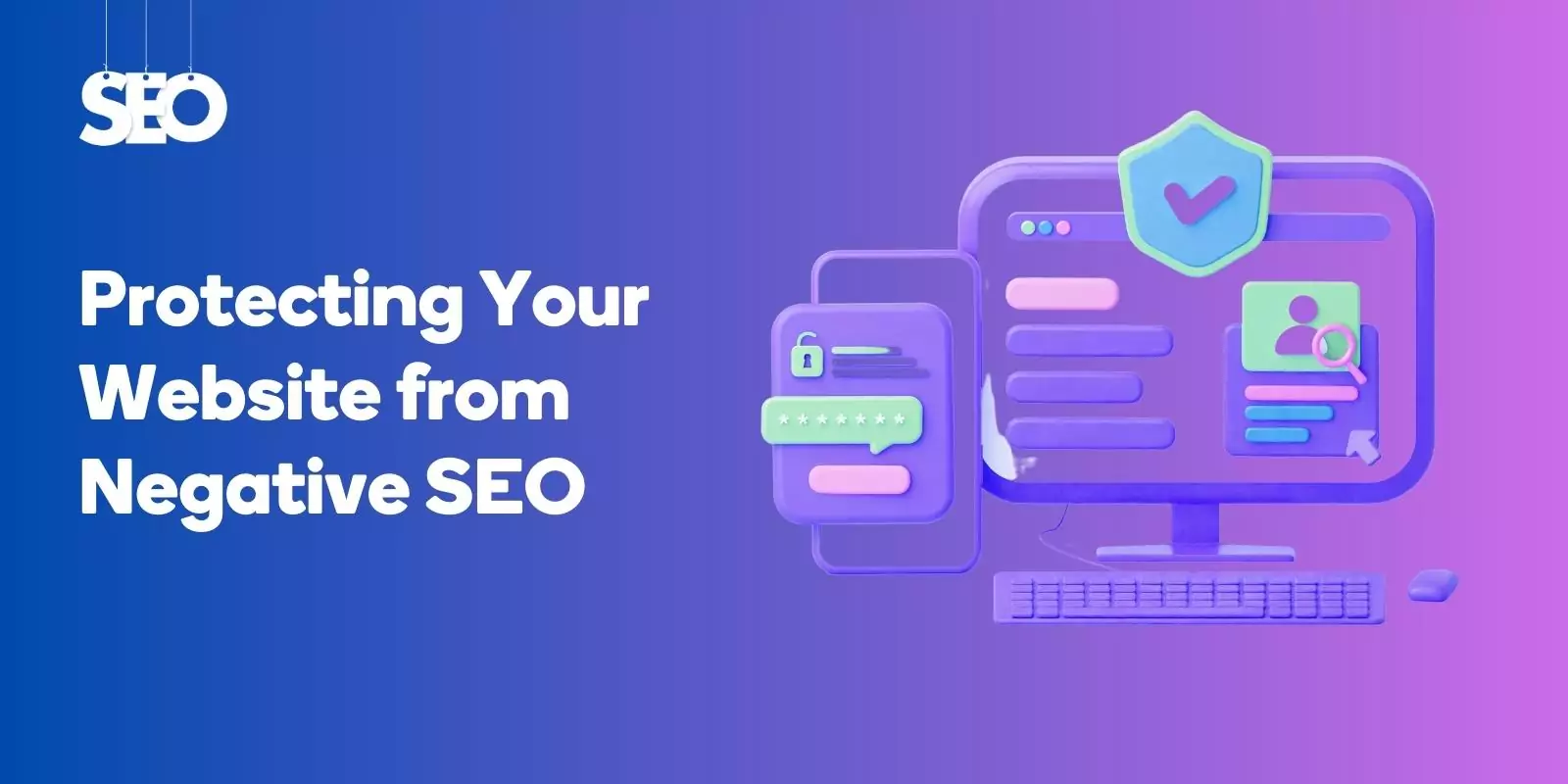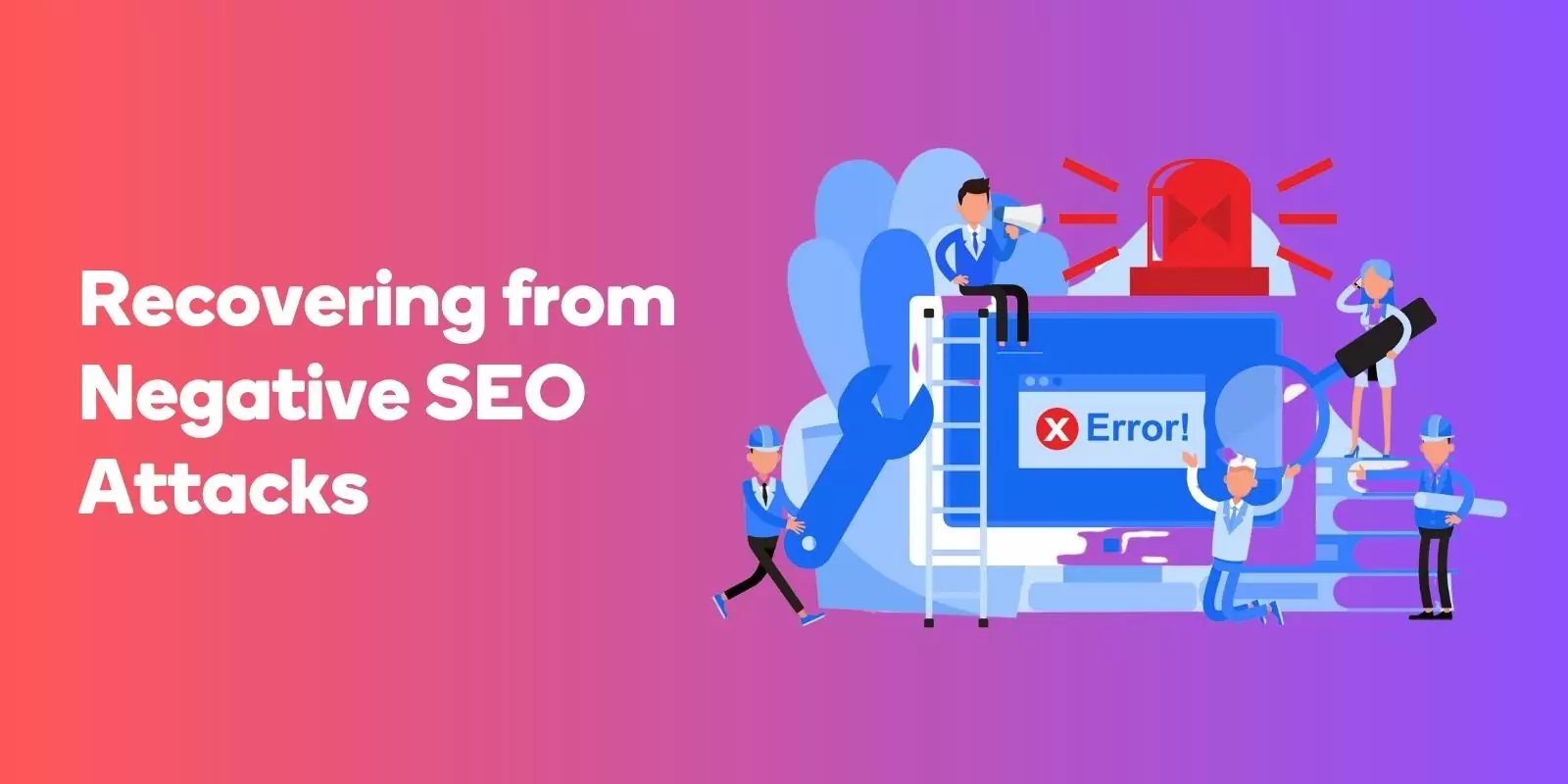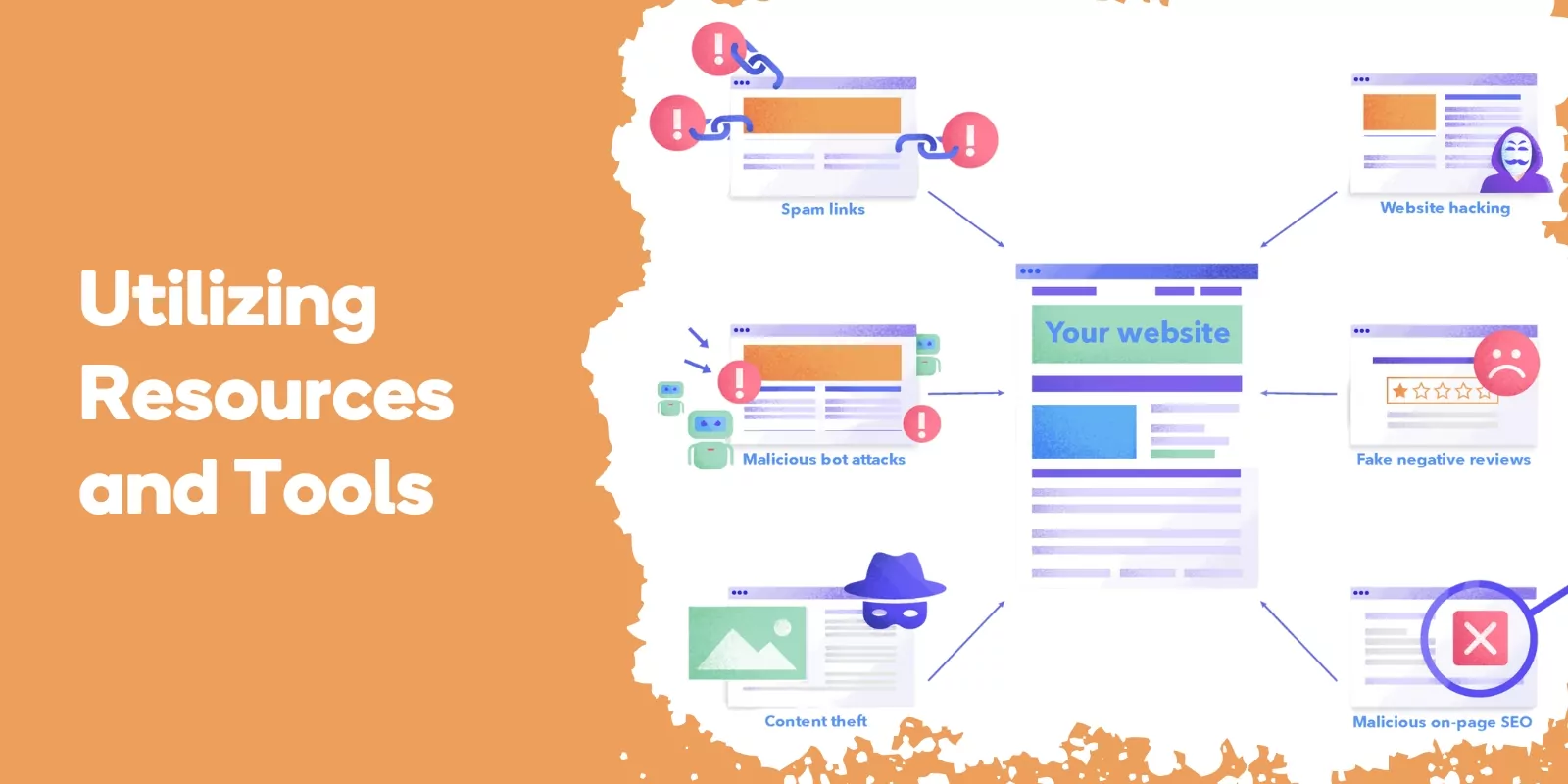Is your online fortress prepared to withstand these malicious attacks?
Worry not, for this comprehensive guide on “how to deal with negative SEO prevention and recovery” will arm you with knowledge and strategies to prevent and recover from negative SEO attacks, fortifying your digital domain.
Understanding Negative SEO
Negative SEO refers to the use of unethical strategies aimed at damaging a website’s ranking and reputation.
The unscrupulous individuals behind these attacks are armed with an arsenal of negative SEO techniques, causing harm not only to their targets but also undermining the integrity of the SEO industry.
Competitors and ill-intentioned individuals alike can initiate such attacks, and even well-established websites are not immune to their nefarious efforts.
Types of Negative SEO Tactics
Negative SEO tactics come in various forms, such as off-page, on-page, and technical attacks. Off-page attacks are conducted on external websites, rather than the targeted website itself.
These tactics typically include building spammy links, generating negative reviews, and using spammy methods on social media platforms. These tactics are designed to tarnish your website’s reputation and search engine rankings from external sources.
On the other hand, negative on-page SEO involves hacking a website and manipulating its content and HTML code.
Technical attacks, such as SQL injections and FTP brute-forcing, target a website’s security infrastructure and disrupt its proper functioning.
No matter the form, these tactics share a common goal: to undermine your website’s reputation and rankings.
Motivations for Negative SEO Attacks
Why would someone resort to negative SEO attacks? The motivations can range from damaging a competitor’s search engine rankings, seeking revenge, or even financial gain. In some cases, attackers may simply harbor malicious intent.
Regardless of the reasons, negative SEO attacks can cause significant damage to a website’s reputation, search rankings, and even its bottom line.
It’s crucial to recognize these threats and take preventive measures to protect your online presence.
Identifying Signs of Negative SEO
To safeguard your website from negative SEO, it is essential to recognize the warning signs and act swiftly.
By monitoring traffic and rankings, analyzing backlinks and anchor text, and evaluating reviews and social media mentions, you can detect potential negative SEO attacks and take appropriate action.
Being proactive in identifying potential threats will empower you to respond effectively and limit the damage caused by negative SEO attacks.
Monitoring Traffic and Rankings
Monitoring traffic and rankings is crucial for detecting and addressing potential negative SEO attacks. Observing changes in traffic, rankings, and keywords can help identify patterns that may indicate an attack.
Additionally, monitoring website performance can uncover intense crawling attacks or hacking attempts, enabling you to take prompt action to protect your website.
Google Webmaster Tools Email Alert is a valuable resource for staying informed about issues related to your website’s indexing or manual penalties.
By setting up email alerts, you can receive timely notifications of potential problems and take quick action to address them.
Examining Backlinks and Anchor Text
Analyzing other websites’ backlink profiles and anchor text ratios is another critical step in detecting negative SEO attacks.
Keep a close eye on your backlink profile for any suspicious activity, such as an abrupt increase in backlinks or low-quality links from unsavory sources.
Unusual linking patterns may also indicate a link spam attack, which can harm your website’s reputation and search engine rankings.
Tools like Ahrefs can aid in monitoring incoming backlinks, helping you identify and address any changes in your backlink profile.
By regularly reviewing your backlinks and anchor text, you can detect and eliminate harmful links before they cause significant damage to your website’s rankings and reputation.
Assessing Reviews and Social Media Mentions
Fake negative reviews can have a devastating impact on a business’s reputation and search rankings, making it essential to detect and address them promptly.
To identify fraudulent negative reviews, authenticate the reviewer and analyze the review content. If you find fake negative reviews, contact the website administrator to report them and request their removal.

Award-Winning
Sales Funnel & Website Expert
Ready for Revenue – Not Just “Traffic”?
- Websites that Work: Clean, fast, built to convert – no design fluff.
- Funnels that Sell for You: Step-by-step paths that turn clicks into paying customers.
- SEO That Hunts Buyers: Show up exactly when prospects reach for their wallets.
Additionally, monitoring your brand mentions on social media can help you detect and address unauthorized usage of your business name or other negative SEO tactics.
Protecting Your Website from Negative SEO
While negative SEO attacks can cause significant harm, there are several strategies and best practices that can help you protect your website.
By strengthening site security, managing and monitoring backlinks, and addressing duplicate content issues, you can safeguard your website against negative SEO and maintain a strong online presence.
Strengthening Site Security
A strong foundation in site security is vital for protecting your website against negative SEO attacks.
Implementing strong passwords, enabling two-factor authentication, and regularly auditing your site for vulnerabilities can help to reinforce your site security and protect against unauthorized access, data breaches, and malware attacks.
Taking extra steps to secure your administrator login can further reduce the risk of malicious actors infiltrating your website.
By employing a combination of robust security measures, you can fortify your website against negative SEO attacks and preserve your website’s reputation and user experience.
Managing and Monitoring Backlinks
Regularly examining your backlink profile is crucial for combating harmful links and preventing negative SEO attacks.
Tools like Ahrefs or Semrush can help you detect new backlinks and monitor changes in your link profile.
Another useful tool is Linkody, which can send email updates about your link profile and even provide a “one-click” Disavowal option to remove detrimental or bad links from your backlink profile.
By proactively managing and monitoring your backlinks, you can minimize the damage caused by negative SEO attacks and maintain a healthy backlink profile.
Additionally, addressing any sudden changes in backlinks can help to prevent potential damage to your site’s ranking.
Addressing Duplicate Content Issues
Duplicate content can harm your website’s search engine rankings and make it more susceptible to negative SEO attacks. To identify and resolve content duplication issues, use tools like Copyscape and Siteliner.
If you discover another website using your content without permission, contact the site owner to request the removal of the web page or content. By addressing duplicate content issues, you can strengthen your website’s search engine rankings and protect against negative SEO threats.
Recovering from Negative SEO Attacks
If your website has been targeted by a negative SEO attack, it is essential to take swift action to limit the damage and restore your search engine rankings.
By identifying and removing harmful links, submitting a reconsideration request to Google, and strengthening your online presence, you can recover from a negative SEO attack and regain your website’s reputation and its inbound links and rankings.
Removing Harmful Links
Identifying and eliminating toxic backlinks is a crucial step in recovering from a negative SEO attack.
Audit tools, as well as manual webmaster efforts, can be employed to detect and remove harmful links from your website.
By regularly reviewing your backlink profile and removing any harmful links, you can minimize the damage caused by negative SEO attacks and maintain a healthy backlink profile.
Google’s Disavow tool can also be used to remove any spammy links and backlinks from your website. This tool allows you to create a disavow list and submit it to Google, which will then assess and remove the specified links from your backlink profile.
Submitting a Reconsideration Request
If your website has been penalized due to a negative SEO attack, submitting a reconsideration request to Google is a crucial step in lifting the penalty and restoring your website’s rankings.
The reconsideration request process involves providing detailed information about the attack and the steps taken to resolve the issue. This includes removing any malicious content, disavowing harmful links, and providing evidence of your efforts to rectify the problem.
Once your reconsideration request is submitted, Google will crawl your website and notify you of its clearance.
In the following weeks, you should observe an increase in your website’s search engine rankings as a result of your efforts to address the negative SEO attack.
Strengthening Your Online Presence
Recovering from a negative SEO attack also involves strengthening your online presence to withstand future attempts.
By producing high-quality content, constructing authoritative backlinks, and being actively engaged on social media, you can build a resilient online presence. A strong online presence not only helps in recovery, but also acts as a deterrent against future negative SEO attacks.
By investing time and resources in creating valuable content, fostering genuine relationships with your audience, and maintaining an active social media presence, you can ensure that your website remains a force to be reckoned with in the face of negative SEO threats.
Utilizing Resources and Tools
To effectively prevent and recover from negative SEO attacks, it is essential to utilize the right tools and resources. With the help of Google, SEO tools, and website monitoring tools, you can stay ahead of potential threats and take appropriate action when needed.
These tools and resources can play a crucial role in safeguarding your website against negative SEO attacks and maintaining a strong online presence.
Website Monitoring Tools
Website monitoring tools can provide valuable insights into your website’s performance, security, and overall health.
Tools like Google Search Console offer comprehensive data on your website’s visibility, traffic, and other metrics, enabling you to identify potential issues and optimize your website for improved performance.
Additional website monitoring tools, such as SEMrush, Ahrefs, Moz, and Screaming Frog, can help you gain a deeper understanding of your website’s performance and uncover any vulnerabilities that may need to be addressed.
By utilizing these tools, you can stay ahead of potential negative SEO attacks and maintain a strong online presence.
SEO Software and Plugins
SEO software and plugins can be invaluable in detecting and preventing negative SEO threats. Tools like Ahrefs or Semrush can help you monitor your backlink profile and detect any changes that may indicate a negative SEO attack.
Plugins like Linkody can help you monitor backlinks and receive email notifications of any changes in your link profile, as well as offer a convenient “one-click” Disavowal option to remove harmful links.
By incorporating these tools and plugins into your SEO strategy, you can effectively monitor your website’s search engines‘ performance, identify potential threats, and take prompt action to prevent negative SEO attacks.
With the right resources at your disposal, you can protect your website’s reputation and search engine rankings, ensuring a strong online presence in the face of negative SEO threats.
Frequently Asked Questions
What causes negative SEO?
Negative SEO is caused by a variety of tactics that are designed to harm a website’s search engine rankings. These tactics are often employed by competitors or malicious entities who aim to decrease a website’s visibility in search engine results pages (SERPs). The primary causes include:
- Link Farms: This is when a large number of low-quality or spammy websites link back to the targeted website. Search engines, like Google, view these low-quality backlinks as an attempt to manipulate rankings, which can lead to a website being penalized or even de-indexed.
- Content Scraping: This is when the content of a website is copied and distributed across the internet without permission. When search engines detect duplicate content, they might devalue the original content or even penalize the site for it.
- Fake Reviews: Negative SEO can be caused by posting numerous fake negative reviews about a business online. This could harm the business’s reputation and trustworthiness, leading to a drop in rankings.
- Hacking and Malware: In some cases, negative SEO can be caused by hacking into a website to introduce harmful elements, such as malware or malicious code. This can lead to the site being flagged as insecure or harmful, thus affecting its rankings.
What is negative SEO for competitors?
Negative SEO for competitors refers to the unethical practice of using negative SEO tactics against a competitor’s website with the aim to damage their search engine rankings.
This can involve deploying a variety of tactics like creating low-quality backlinks to the competitor’s site, duplicating their content and spreading it across the internet, posting fake negative reviews about their business, or even hacking their website to introduce harmful elements. The goal is to decrease the competitor’s visibility in search engine results and negatively affect their online reputation.
Is negative SEO illegal?
While there’s no law specifically addressing negative SEO, many of the tactics employed in negative SEO are illegal under various laws. For example, hacking a website and adding malicious code or malware is illegal under computer crime laws.
Similarly, defaming a business by posting false information or reviews can be considered libel, which is also illegal. However, it can be challenging to track down the perpetrators of negative SEO and bring them to justice due to the anonymous nature of the internet. It’s also important to note that even if not strictly illegal, negative SEO is certainly unethical and against the guidelines set by search engines like Google.
Conclusion
In conclusion, negative SEO attacks pose a significant threat to websites, but with the right knowledge, strategies, and tools, you can effectively prevent and recover from these malicious attempts.
By understanding the nature of negative SEO, recognizing the warning signs, implementing protective measures, and utilizing the available resources, you can safeguard your website’s reputation and search engine rankings.
Armed with this comprehensive guide, you are now equipped to face the dark arts of negative SEO and emerge victorious in the battle for online supremacy.
